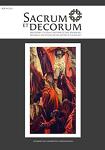Tradycja, stygnąca pobożność i niejasne odczucie bóstwa. François René de Chateaubriand a kryzys sztuki religijnej w XIX wieku
Tradition, decreasing piety and a vague sense of the Divine. François René de Chateaubriand and the crisis of sacred art in the 19th century
Author(s): Piotr KrasnySubject(s): Cultural history
Published by: Wydawnictwo Uniwersytetu Rzeszowskiego
Keywords: religious art; art theory; France; 19th century; the French Revolution; François René de Chateaubriand
Summary/Abstract: Many consider François René de Chateaubriand as the thinker primarily responsible for consolidating radically conservative and fideistic attitudes after the French Revolution. It was allegedly under his influence that French sacred art of the 19th century plunged into an era of barren historicism, which identified religious significance with allusions to the artistic tradition of the pre-revolutionary state. The origins of this idea are commonly traced back to Chateaubriand’s statements on art in his apologetic treatise entitled The Genius of Christianity [Génie du Christianisme] It is should be noted, however, that these reflections are limited to but a dozen pages in the book, and it would be a futile attempt to use them as specific guidance on how sacred art should be created. Evident in these pages is Chateaubriand’s admiration for the architecture of Gothic cathedrals, which evoke in him “a kind of awe and a vague sentiment of the Divinity”; he is clearly awed by their solemn ambience, reverberating with echoes of past ages, which “raise their venerable voices from the bosom of the stones, and are heard in every corner of the vast cathedral.” These statements may indeed be easily read as an encouragement to build churches in a neo-Gothic style, which will always appeal to the common folk. It should be borne in mind, however, that the neo-Gothic rose to prominence in French art thirty years after the publication of The Genius of Christianity. If we assume that the book was treated as an inspiration for reviving past architectural solutions, it may strike us as surprising that the motifs chosen often went directly against Chateaubriand’s actual recommendations. At the beginning of the 19th century, French religious art returned to the forms of classicizing baroque and early classicism, which were criticized by Chateaubriand for their pagan origins and their inability to inspire true Christian piety. Therefore, it seems unlikely that the choice of “retrospective” solutions was influenced by the The Genius of Christianity; rather, it was informed by specific academic tastes dominant in the French artistic milieu at the time and the ideal of “restoring” French religious art to what it used to be before the iconoclasm and de-christianization championed by the French Revolution.
Journal: Sacrum et Decorum. Materiały i studia z historii sztuki sakralnej
- Issue Year: 2011
- Issue No: 4
- Page Range: 8-19
- Page Count: 12
- Language: Polish

